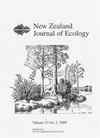Effect of plant composition on epigeal spider communities in northern New Zealand forest remnants
IF 1.4
3区 环境科学与生态学
Q3 ECOLOGY
引用次数: 0
Abstract
: Te Paki Ecological District (TPED) in northern Northland, New Zealand, is well known as an ecologically significant centre of endemism. However, due to extensive anthropogenic habitat degradation, native forest has been reduced to small, isolated remnants and many of its endemic species are threatened with extinction. Epigeal spider communities (species living on or near the ground) were surveyed within TPED by pitfall trapping at seven native forest remnants differing in plant composition and apparent seral stage to investigate how spider communities varied within them. Surveys were conducted four times over a 12-month period coinciding with winter, spring, summer and autumn. Changes in spider communities were related to differences in plant composition, which were in turn associated with differences in apparent seral stage of the vegetation. Spider communities in forests at later seral stages were dominated by species such as Rinawa sp., Porrhothele sp. and Uliodon sp., whereas Euryopis nana , Cambridgea reinga , Stanwellia hollowayi and Hypodrassodes apicus were most prevalent in remnants at earlier seral stages. These species could potentially serve as useful bioindicators of ecological succession or restoration. Apart from soil organic matter content none of the predictor variables tested, including plant species richness, were significantly correlated with spider richness or diversity. Spider richness and diversity are most likely determined by a complex interaction of environmental and temporal factors that operate at different spatial scales. This study has increased our understanding of the ecological associations of spider communities and established that TPED is an important centre of endemism for spiders in New Zealand. We have also demonstrated the importance of forest remnants as reservoirs of indigenous spider diversity and helped resolve several historical taxonomic issues. Furthermore, we demonstrate the need for taxonomic research in this region of New Zealand and highlight the value of such biodiversity surveys.植物组成对新西兰北部森林残余物中表皮蜘蛛群落的影响
:新西兰北部的特帕基生态区(TPED)是著名的具有重要生态意义的地方病中心。然而,由于广泛的人为栖息地退化,原生森林已减少为小型、孤立的残余,其许多特有物种面临灭绝的威胁。通过在七个不同植物组成和明显seral阶段的原生森林遗迹进行陷阱诱捕,在TPED内调查了Epigeal蜘蛛群落(生活在地面上或附近的物种),以调查蜘蛛群落在其中的变化。在冬季、春季、夏季和秋季的12个月内,共进行了四次调查。蜘蛛群落的变化和植物组成的差异有关,而植物组成的变化又和植被表观演替阶段的差异有关。林后期蜘蛛群落以Rinawa sp.、Porrothele sp.和Uliodon sp.等物种为主,而Euryopis nana、Cambridgea reinga、Stanwellia holowayi和Hypodrassodes apicus在林早期残留中最为普遍。这些物种可能成为生态演替或恢复的有用生物指标。除了土壤有机质含量外,测试的预测变量,包括植物物种丰富度,都与蜘蛛丰富度或多样性无关。蜘蛛的丰富度和多样性很可能是由在不同空间尺度上运作的环境和时间因素的复杂相互作用决定的。这项研究增加了我们对蜘蛛群落生态关联的理解,并确定TPED是新西兰蜘蛛特有病的重要中心。我们还证明了森林遗迹作为本土蜘蛛多样性宝库的重要性,并帮助解决了几个历史分类学问题。此外,我们证明了在新西兰这一地区进行分类学研究的必要性,并强调了这种生物多样性调查的价值。
本文章由计算机程序翻译,如有差异,请以英文原文为准。
求助全文
约1分钟内获得全文
求助全文
来源期刊

New Zealand Journal of Ecology
环境科学-生态学
CiteScore
3.00
自引率
12.50%
发文量
35
审稿时长
>36 weeks
期刊介绍:
The New Zealand Journal of Ecology is a biannual peer-reviewed journal publishing ecological research relevant to New Zealand/Aotearoa and the South Pacific. It has been published since 1952 (as a 1952 issue of New Zealand Science Review and as the Proceedings of the New Zealand Ecological Society until 1977). The Journal is published by the New Zealand Ecological Society (Inc.), and is covered by Current Contents/Agriculture, Biology and Environmental Science, GEOBASE, and Geo Abstracts.
 求助内容:
求助内容: 应助结果提醒方式:
应助结果提醒方式:


